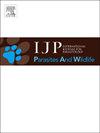Arthropod-borne pathogens in European bison Bison bonasus (Linnaeus, 1758)
IF 2
3区 医学
Q3 ECOLOGY
International Journal for Parasitology-Parasites and Wildlife
Pub Date : 2025-07-04
DOI:10.1016/j.ijppaw.2025.101110
引用次数: 0
Abstract
The prevalence of vector-borne pathogens in 81 European bison (Bison bonasus) was determined by nested PCR and DNA sequencing. Trypanosoma sp. Infections were detected in blood from 66.67 % of the studied animals, with the highest prevalence in Knyszyn Forest (82.67 %). Anaplasma phagocytophilum infections were found in 38.27 % of cases, with the highest prevalence in Białowieża Forest (45.45 %). Anaplasma infection rates were influenced by location and age, with older animals showing lower prevalence. Phylogenetic analysis confirmed that Trypanosoma sequences obtained from European bison were closely related to T. theileri, suggesting T. wrublewskii may be a synonym. This study provides new insights into the distribution of vector-borne pathogens in European bison, emphasizing their high prevalence in free-ranging populations. These findings contribute to a better understanding of European bison health and potential disease transmission risks in European ecosystems.

欧洲野牛中节肢动物传播的病原体(Linnaeus, 1758)
采用巢式PCR和DNA测序法测定了81头欧洲野牛(bison bonasus)媒介传播病原体的流行情况。66.67%的动物血液中检出锥虫,其中以克尼辛森林最高(82.67%)。嗜吞噬细胞无原体感染占38.27%,以Białowieża森林感染率最高(45.45%)。无原体感染率受地点和年龄的影响,年龄较大的动物患病率较低。系统发育分析证实,从欧洲野牛中获得的锥虫序列与T. theileri密切相关,表明T. wrublewskii可能是其同义词。这项研究为欧洲野牛媒介传播病原体的分布提供了新的见解,强调了它们在自由放养种群中的高流行率。这些发现有助于更好地了解欧洲野牛的健康状况和欧洲生态系统中潜在的疾病传播风险。
本文章由计算机程序翻译,如有差异,请以英文原文为准。
求助全文
约1分钟内获得全文
求助全文
来源期刊

International Journal for Parasitology-Parasites and Wildlife
Medicine-Infectious Diseases
CiteScore
3.80
自引率
5.60%
发文量
113
审稿时长
45 days
期刊介绍:
The International Journal for Parasitology: Parasites and Wildlife (IJP-PAW) publishes the results of original research on parasites of all wildlife, invertebrate and vertebrate. This includes free-ranging, wild populations, as well as captive wildlife, semi-domesticated species (e.g. reindeer) and farmed populations of recently domesticated or wild-captured species (e.g. cultured fishes). Articles on all aspects of wildlife parasitology are welcomed including taxonomy, biodiversity and distribution, ecology and epidemiology, population biology and host-parasite relationships. The impact of parasites on the health and conservation of wildlife is seen as an important area covered by the journal especially the potential role of environmental factors, for example climate. Also important to the journal is ''one health'' and the nature of interactions between wildlife, people and domestic animals, including disease emergence and zoonoses.
 求助内容:
求助内容: 应助结果提醒方式:
应助结果提醒方式:


